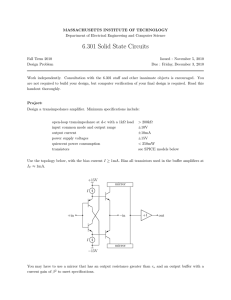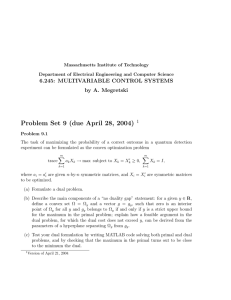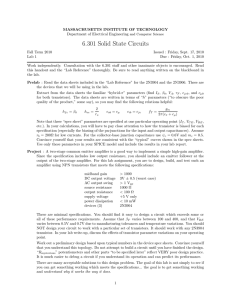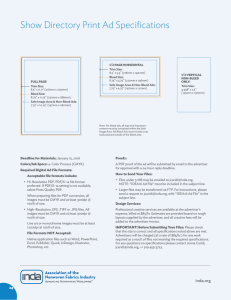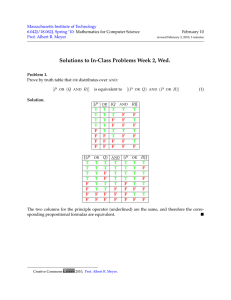A Factor Graph Model for Software Bug Finding
advertisement
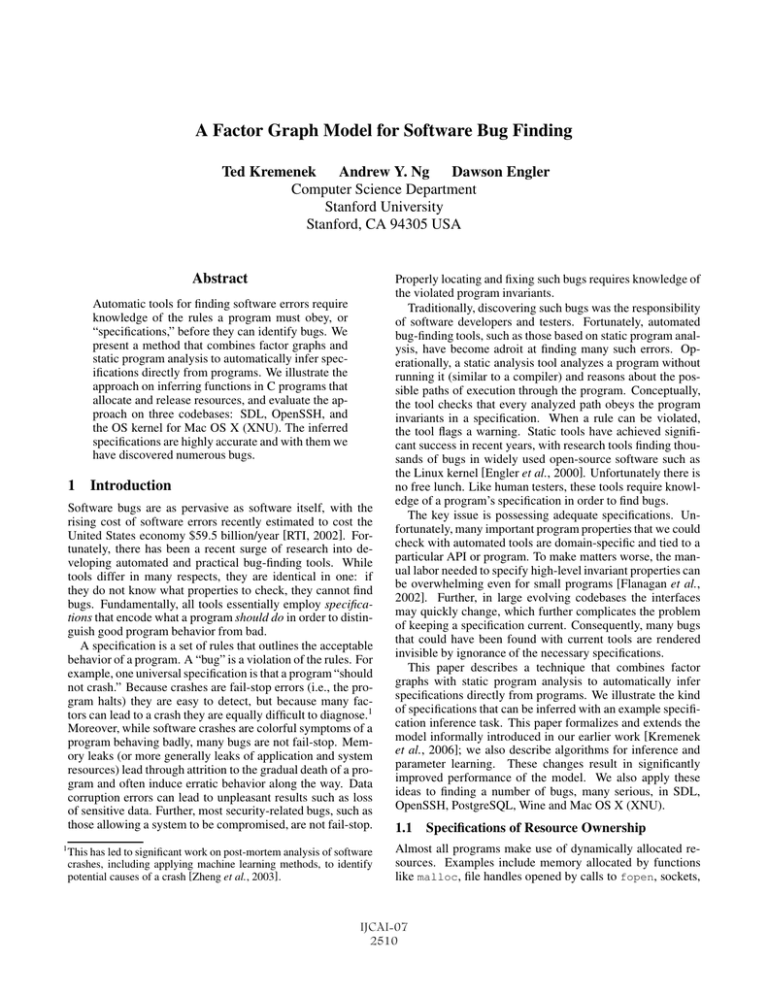
A Factor Graph Model for Software Bug Finding
Ted Kremenek
Andrew Y. Ng Dawson Engler
Computer Science Department
Stanford University
Stanford, CA 94305 USA
Abstract
Automatic tools for finding software errors require
knowledge of the rules a program must obey, or
“specifications,” before they can identify bugs. We
present a method that combines factor graphs and
static program analysis to automatically infer specifications directly from programs. We illustrate the
approach on inferring functions in C programs that
allocate and release resources, and evaluate the approach on three codebases: SDL, OpenSSH, and
the OS kernel for Mac OS X (XNU). The inferred
specifications are highly accurate and with them we
have discovered numerous bugs.
1 Introduction
Software bugs are as pervasive as software itself, with the
rising cost of software errors recently estimated to cost the
United States economy $59.5 billion/year [RTI, 2002]. Fortunately, there has been a recent surge of research into developing automated and practical bug-finding tools. While
tools differ in many respects, they are identical in one: if
they do not know what properties to check, they cannot find
bugs. Fundamentally, all tools essentially employ specifications that encode what a program should do in order to distinguish good program behavior from bad.
A specification is a set of rules that outlines the acceptable
behavior of a program. A “bug” is a violation of the rules. For
example, one universal specification is that a program “should
not crash.” Because crashes are fail-stop errors (i.e., the program halts) they are easy to detect, but because many factors can lead to a crash they are equally difficult to diagnose.1
Moreover, while software crashes are colorful symptoms of a
program behaving badly, many bugs are not fail-stop. Memory leaks (or more generally leaks of application and system
resources) lead through attrition to the gradual death of a program and often induce erratic behavior along the way. Data
corruption errors can lead to unpleasant results such as loss
of sensitive data. Further, most security-related bugs, such as
those allowing a system to be compromised, are not fail-stop.
1
This has led to significant work on post-mortem analysis of software
crashes, including applying machine learning methods, to identify
potential causes of a crash [Zheng et al., 2003].
Properly locating and fixing such bugs requires knowledge of
the violated program invariants.
Traditionally, discovering such bugs was the responsibility
of software developers and testers. Fortunately, automated
bug-finding tools, such as those based on static program analysis, have become adroit at finding many such errors. Operationally, a static analysis tool analyzes a program without
running it (similar to a compiler) and reasons about the possible paths of execution through the program. Conceptually,
the tool checks that every analyzed path obeys the program
invariants in a specification. When a rule can be violated,
the tool flags a warning. Static tools have achieved significant success in recent years, with research tools finding thousands of bugs in widely used open-source software such as
the Linux kernel [Engler et al., 2000]. Unfortunately there is
no free lunch. Like human testers, these tools require knowledge of a program’s specification in order to find bugs.
The key issue is possessing adequate specifications. Unfortunately, many important program properties that we could
check with automated tools are domain-specific and tied to a
particular API or program. To make matters worse, the manual labor needed to specify high-level invariant properties can
be overwhelming even for small programs [Flanagan et al.,
2002]. Further, in large evolving codebases the interfaces
may quickly change, which further complicates the problem
of keeping a specification current. Consequently, many bugs
that could have been found with current tools are rendered
invisible by ignorance of the necessary specifications.
This paper describes a technique that combines factor
graphs with static program analysis to automatically infer
specifications directly from programs. We illustrate the kind
of specifications that can be inferred with an example specification inference task. This paper formalizes and extends the
model informally introduced in our earlier work [Kremenek
et al., 2006]; we also describe algorithms for inference and
parameter learning. These changes result in significantly
improved performance of the model. We also apply these
ideas to finding a number of bugs, many serious, in SDL,
OpenSSH, PostgreSQL, Wine and Mac OS X (XNU).
1.1
Specifications of Resource Ownership
Almost all programs make use of dynamically allocated resources. Examples include memory allocated by functions
like malloc, file handles opened by calls to fopen, sockets,
IJCAI-07
2510
1.
2.
3.
4.
5.
6.
FILE * fp1 = fopen( "myfile.txt", "r" );
FILE * fp2 = fdopen( fd, "w" );
fread( buffer, n, 1, fp1 );
fwrite( buffer, n, 1, fp2 );
fclose( fp1 );
fclose( fp2 );
Figure 1: Example use of standard C I/O functions.
¬co
end-ofpath
co
Owned
Claimed
end-ofpath
ro
Bug:
Leak
Uninit
Deallocator
¬co
end-of-path,¬co
co
co
¬ro
Ownership
Bug:
Invalid Use
¬co
co
¬Owned
end-of-path
ContraOwnership
Figure 2: DFA for a static analysis checker to find resource errors.
Shaded final states represent error states (bugs).
database connections, and so on. Functions that “allocate”
resources, or allocators, typically have a matching deallocator function, such as free and fclose, that releases the resource. Even if a language supports garbage collection, programmers usually must enforce manual discipline in managing arbitrary allocated resources in order to avoid resourcerelated bugs such as leaks or “use-after-release” errors.
Numerous tools have been developed to find resource bugs,
with the majority focusing on finding bugs for uses of wellknown allocators such as malloc [Heine and Lam, 2003].
Many systems, however, define a host of allocators and deallocators to manage domain-specific resources. Because the
program analysis required to find resource bugs is generally the same for all allocators and deallocators, current tools
could readily be extended to find resource bugs for domainspecific allocators if they were made aware of such functions.
A more general concept, however, that subsumes knowing
allocators and deallocators is knowing what functions return
or claim ownership of resources. To manage resources, many
programs employ the ownership idiom: a resource has at any
time exactly one owning pointer (or handle) which must eventually release the resource. Ownership can be transferred
from a pointer by storing it into a data structure or by passing
it to a function that claims it (e.g., a deallocator). Although
allocators and deallocators respectively return and claim ownership, many functions that return ownership have a contract
similar to an allocator but do not directly allocate resources;
e.g., a function that dequeues an object from a linked list and
returns it to the caller. Once the object is removed from the
list, the caller must ensure that the object is fully processed.
A similar narrative applies to functions that claim ownership.
By knowing all functions that return and claim ownership, we
can detect a wider range of resource bugs.
This paper explores the problem of inferring domainspecific functions in C programs that return and claim ownership. Our formulation uses an encoding of this set of functions that is easily consumed by a simple static analysis tool,
or checker, which we briefly describe. Figure 1 depicts a
contrived code fragment illustrating the use of several standard I/O functions in C. For the return values of fopen and
fdopen, we can associate the label ro (returns ownership)
or ¬ro. For the input arguments (with a pointer type) of
fwrite, fread, and fclose we can associate labels co
(claims ownership) or ¬co. These labels can be used by a simple checker that operates by tracing the possible paths within
the function where fp1 and fp2 are used, and, along those
paths, simulate for each pointer the property DFA in Figure 2.
Every time a pointer is passed as an argument to a function
call or returned from a function the corresponding label is
consulted and the appropriate transition is taken. An “endof-path” indicates that the end of the function was reached.
There are five final states. The states Leak and Invalid Use
are error states (shaded) and indicate buggy behavior (Invalid
Use captures both “use-after-release” errors as well as claiming a non-owned pointer). The other final states indicate a
pointer was used correctly, and are discussed later in further
detail. Further details regarding the implementation of the
checker can be found in Kremenek et al. [2006].
1.2
Our Approach
While specifications conceivably come in arbitrary forms, we
focus on inferring specifications where (1) the entire set of
specifications is discrete and finite and (2) a given specification for a program can be decomposed into elements that describe the behavior of one aspect of the program. For example, in the ownership problem if there are m functions whose
return value can be labeled ro and n function arguments that
can be labeled co then there are 2m 2n possible combined labellings. In practice, there are many reasonable bug-finding
problems whose specifications map to similar domains.
Our primary lever for inferring specifications is that programs contain latent information, often in the form of “behavioral signatures,” that indirectly documents their high-level
properties. Recall that the role of specifications is to outline
acceptable program behavior. If we assume that programs
for the most part do what their creators intended (or at least
in a relative sense “bugs are rare”) then a likely specification
is one that closely matches the program’s behavior. Thus, if
such a specification was fed to a static analysis checker, the
checker should flag only a few cases of errant behavior in the
program. Finally, latent information may come in a myriad of
other forms, such as naming conventions for functions (e.g.
“alloc”) that provide hints about the program’s specification.
This motivates an approach based on probabilistic reasoning, which is capable of handling this myriad of information
that is coupled with uncertainty. Our solution employs factor
graphs [Yedidia et al., 2003], where a set of random variables in a factor graph represent the specifications we desire
to infer, and factors represent constraints implied by behavioral signatures. The factor graph is constructed by analyzing
a program’s source code, and represents a joint probability
distribution over the space of possible specifications. Once
the factor graph is constructed, we employ Gibbs sampling to
infer the most likely specifications.
IJCAI-07
2511
2 Factor Graph Model
We now present our factor graph model for inferring specifications. We illustrate it in terms of the ownership problem,
and make general statements as key concepts are introduced.
We begin by mapping the space of possible specifications
to random variables. For each element of the specification
with discrete possible values we have a random variable Ai
with the same domain. For example, in the ownership problem for each return value of a function “foo” in the codebase
we have a random variable Afoo:ret with domain {ro, ¬ro}.
Further, for the ith argument of a function “baz” we have a
random variable Abaz:i with domain {co, ¬co}. We denote
this collection of variables as A, and a compound assignment
A = a represents one complete specification from the set of
possible specifications.
2.1
Preliminaries
Our goal is to define a joint distribution for A with a factor
graph. We now review key definitions pertaining to factor
graphs [Yedidia et al., 2003].
Definition 1 (Factor) A factor f for a set of random variables C is a mapping from val(C) to R+ .
Definition 2 (Gibbs Distribution) A Gibbs distribution P
over a set of random variables X = {X1 , . . . , Xn } is defined
in terms of a set of factors {fj }Jj=1 (with associated random
variables {Cj }Jj=1 , Cj ⊆ X) such that:
J
1 P(X1 , . . . , Xn ) =
fj (Cj ).
(1)
Z j=1
The normalizing constant Z is the partition function.
Definition 3 (Factor Graph) A factor graph is a bipartite
graph that represents a Gibbs distribution. Nodes correspond
to variables in X and to the factors {fj }Jj=1 . Edges connect
variables and factors, with an undirected edge between Xi
and fj if Xi ∈ Cj .
2.2
Overview of Model Components
We now define the factors in our model. Maintaining terminology consistent with our previous work, we call the factor graphs constructed for specification inference Annotation
Factor Graphs (AFGs). The name follows from that the specifications we infer (e.g. ro and co) serve to “annotate” the behavior of program components. While often the only random
variables in an AFG will be A (i.e., X = A), other variables,
such as hidden variables, can be introduced as needed.
There are two categories of factors in an AFG that are used
to capture different forms of information for specification inference. The first set of factors, called check factors, are used
to extract information from observed program behavior. A
given specification A = a that we assign to the functions in a
program will determine, for each tracked pointer, the outcome
of the checker described in Section 1.1. These outcomes reflect behaviors the checker observed in the program given the
provided specification (e.g., resource leaks, a pointer being
properly claimed, and so on). Our insight is that (1) some behaviors are more likely than others (e.g., errors should occur
rarely) and that (2) some behaviors are harder for a program
to “coincidentally” exhibit; thus when we observe such behaviors in a program they may provide strong evidence that a
given specification is likely to be true. Check factors incorporate into the AFG both our beliefs about such behaviors and
the mechanism (the checker) used to determine what behaviors a program exhibits.
The second set of factors are used to model arbitrary
domain-specific knowledge. This includes prior beliefs about
the relative frequency of certain specifications, knowledge
about suggestive naming conventions (e.g, the presence of
“alloc” in a function’s name implies it is an ro), and so on.
We now discuss both classes of factors in turn.
2.3
Check Factors
We now describe check factors, which incorporate our beliefs
about the possible behaviors a program may exhibit and the
specifications they imply.
Each final state in our checker corresponds to a separate
behavioral signature observed in the program given a specification A = a. The checker observes five behavioral signatures, two of which indicate different kinds of bugs (leaks and
everything else), and three which identify different kinds of
“good” behavior. By distinguishing between different behaviors, we can elevate the probability of values of A that induce
behaviors that are more consistent with our beliefs.
First, we observe that (in general) bugs occur rarely in programs. Although not a perfect oracle, the checker can be employed to define an error as a case where the DFA in Figure 2
ends in an error state. Thus an assignment to A that causes
the checker to flag many errors is less likely than an assignment that leads to few flagged errors. Note that we should
not treat errors as being impossible (i.e., only consider specifications that cause the checker to flag no errors) because (1)
real programs contain bugs and (2) the checker may flag some
false errors even for a bug-free program.
Further, not all kinds of errors occur with equal frequency.
In practice Invalid Use errors occur far less frequently than
Leak s. Thus, for two different specifications that induce the
same number of errors, the one that induces more Leak s than
Invalid Use errors is the more likely specification.
Finally, errors aside, we should not equally weight observations of different kinds of good program behavior. For
example, the Deallocator signature recognizes the pattern
that once an owned pointer is claimed it is never subsequently used, while Ownership matches behavior that allows
a claimed pointer to be used after it is claimed. The former is a behavioral signature that is much harder for a set
of functions to fit by chance. Consequently when we observe the Deallocator pattern we could potentially weight it
as stronger evidence for a given specification than if a code
fragment could only obey the Ownership pattern. Finally, the
Contra-Ownership pattern, which recognizes all correct use
of a non-owned pointer, is the easiest pattern to fit: all functions can be labeled ¬ro and ¬co and the checker will never
flag an error. Such a specification is useless, however, because we wish to infer ro and co functions! Thus we should
potentially “reward” observations of the Ownership or Deallocator signatures more than the Contra-Ownership pattern.
In other words, we are willing to tolerate some errors if a set
IJCAI-07
2512
Afopen:ret
Afread:3
Afclose:0
Afdopen:ret
Multiple execution paths. Note that the value of the check
is a summary of all the analyzed paths within the function for
that pointer. Each analyzed path may end in a different state
in the DFA. Instead of reporting results for all analyzed paths,
we summarize them by reporting the final state from the analyzed paths that appears earliest in the following partial order:
Afwrite:3
Invalid Use ≺ Leak ≺ Contra-Ownership
≺ Ownership ≺ Deallocator
Figure 3: Factor graph model for the code in Figure 1. Circular
nodes correspond to variables and square nodes to factors. The
shaded factors indicate check factors, while the top row depicts
factors modeling prior beliefs.
of functions appear to consistently fit either the Deallocator
or Ownership signatures.
We now discuss how these ideas are modeled using factors. We first atomize the output of the checker into checks.
A check is a distinct instance in the program where the specification could be obeyed or disobeyed. For the ownership
problem, we have a check for every statement of the form
“p = foo()” where a pointer value is returned from a called
function. For the code in Figure 1 we have one check for
fp1 and another for fp2. In general, the actual definition of a
check will depend on the specifications we are trying to infer,
but essentially each check represents a distinct observation
point of a program’s behavior.
Once we define the set of checks for a codebase, for
each check we create a corresponding check factor, denoted
fcheck(i) , in the AFG. Check factors represent (1) the analysis
result of the checker at each check when running the checker
using a provided set of values for A and (2) our preferences
over the possible outcomes of each check. The variables in
A associated with a given fcheck(i) , denoted Acheck(i) , are
those whose values could be consulted by the checker to determine the check’s outcome. For example, Figure 3 depicts
the factor graph for the code example in Figure 1. We have
two check factors (shaded), one for fp1 and fp2 respectively.
Because for fp1 the checker needs only consult the specifications represented by the variables Afopen:ret , Afread:4 and
Afclose:1 , these variables are those associated with fcheck(fp1) .
Check factors have a simple mathematical definition. If
Ci (acheck(i) ) represents the output of the checker for check i
when Acheck(i) = acheck(i) , then fcheck(i) is defined as:
fcheck(i) (acheck(i) ) = eθc : if Ci (acheck(i) ) = c
Thus a check factor is encoded with a set of real-valued parameters (θc ∈ R), one for each distinct behavior observed by
the checker. These parameters are shared between all check
factors that observe the same set of behaviors,2 and are used
to encode our intuitions about program behavior and the specifications they imply. For example, we expect that the parameters for error states, θLeak and θInvalid Use , will have lower
values than the remaining parameters (i.e., errors are rare).
While parameters can be specified by hand [Kremenek et al.,
2006], in this paper we focus on learning them from partially
known specifications and observing if the learned parameters
both (1) match with our intuitions and (2) compare in quality
to the specifications inferred using hand-tuned parameters.
2
Multiple checkers with different check factors can conceptually be
used to analyze the program for different behavioral profiles.
For example, if on any path the analysis encounters an Invalid
Use state, it reports Invalid Use for that check regardless of
the final states on the other paths. The idea is to report bad
behavior over good behavior.
2.4
Further Modeling: Domain Knowledge
Beyond exploiting the information provided by a checker, the
factor graph allows us to incorporate useful domain knowledge. We discuss two examples for the ownership problem.
Prior beliefs. Often we have prior knowledge about the
relative frequency of different specifications. For example,
most functions do not claim ownership of their arguments and
should be labeled ¬co. Such hints are easily modeled as a
single factor attached to each Ai variable. We attach to each
Afoo:i a factor f (Afoo:i = x) = eθx . The two parameters,
θco and θ¬co , are shared between all factors created by this
construction. Analogously we define similar factors for each
Afoo:ret . These factors are depicted at the top of Figure 3.
Suggestive naming. Naming conventions for functions
(e.g., a function name containing “alloc” implies the return
value is ro) can be exploited in a similar fashion. We selected a small set of well-known keywords K (|K| = 10)
containing words such as “alloc”, “free” and “new.” To model
keyword correlation with ro specifications, for each Afoo:ret
whose functions contains the keyword kw we construct a single factor associated with Afoo:ret :
f (Afoo:ret = x) = eθkw:x
(2)
Since x ∈ {ro, ¬ro} this factor is represented by two parameters (per keyword). These parameters are shared between all
factors created by this construction. Note that the factor is
present only if the function has the keyword as a substring of
it’s name; while the presence of a keyword may be suggestive of a function’s role, we have observed the absence of a
keyword is usually uninformative.
Keyword correlation for co specifications is similarly modeled, except since a function may contain multiple arguments,
each of which may be labeled co, we construct one “keyword
factor” over all the Afoo:i variables, denoted Afoo:parms , for
a function foo:
f (afoo:parms ) = eθkw:co I{∃i|Afoo:i =co} +θkw:¬co I{∀i|Afoo:i =¬co}
(3)
Thus, if any of foo’s arguments has the specification co then
the factor has value eθkw:co (and eθkw:¬co otherwise). For clarity, keyword factors have been omitted in Figure 3.
3 Inference
Once the factor graph is constructed, we employ Gibbs sampling to sample from the joint distribution. For each Ai
IJCAI-07
2513
we estimate the probability it has a given specification (e.g.,
P (Ai = ro)) and rank inferred specifications by their probabilities. Analogously, we estimate for each check factor
fcheck(i) the probability that the values of Acheck(i) cause the
checker to flag an error. This allows us to also rank possible
errors by their probabilities.
When updating a value for a given Aj ∈ A, we must
recompute the value of each check factor fcheck(i) where
Aj ∈ Acheck(i) . This requires actually running the checker.
Because at any one time Gibbs sampling has a complete assignment to all random variables, the checker simply consults the current values of A to determine the outcome of the
check. This clean interface with the checker is the primary
reason we employed Gibbs sampling.
While our checker is relatively simple, the analysis is still
very expensive when run repeatedly. To compensate, we
cache analysis results by monitoring which values of A are
consulted by the checker to determine the outcome of a check.
This results in a speedup of two orders of magnitude.
We experienced serious issues with mixing. This is a byproduct of the check factors, since values of several Ai variables may need to be flipped before the outcome of a check
changes. We explored various strategies to improve mixing,
and converged to a simple solution that provided consistently
acceptable results. We run 100 chains for N = 1000 iterations and at the end of each chain record a single sample.
Moreover, for each chain, we apply the following annealing
schedule so that each factor fi has the following definition on
the kth Gibbs iteration:
(k)
k
fi (Ai ) = fi (Ai )min( 0.75N ,1)
(4)
This simple strategy significantly improved the quality of our
samples. While satisfied by the empirical results of this procedure, we continue to explore faster alternatives.
4 Learning
We now discuss our procedure for parameter learning. The
factors we have discussed take the exponential form of
f (Cj = cj ) = eθcj (with θcj ∈ R). The set of parameters
θ for these factors can be learned from (partially) observed
data, denoted D = d, by using gradient ascent to maximize
the log-likelihood of d. Generally D ⊂ A, representing partially known specifications. We omit the derivation of the
gradient, as it is fairly standard. For the case where a single
parameter θcj appears in a single factor fj , the corresponding
term of the gradient is:
∂ log p (d|θ)
= EP Clamped [I{Cj =cj } ] − EP Unclamped [I{Cj =cj } ]
∂θcj
(5)
Here P Clamped represents the conditional distribution over all
variables in the factor graph when D is observed, while
P Unclamped represents the distribution with no observed data.
If a parameter appears in multiple factors, the gradient term
for θcj is summed over all factors in which it appears.
4.1
Implementation: Heuristics and Optimizations
We now briefly describe a few key features of our implementation of gradient ascent for our domain.
AFG Size
Manually Classified Specifications
Codebase Lines (103 ) |A| # Checks ro ¬ro
SDL
OpenSSH
XNU
51.5 843
80.12 717
1381.1 1936
577 35
3416 45
9169 35
ro
¬ro
co
¬co
Total
25 1.4 16 31 0.51
28 1.6 10 108 0.09
49 0.71 17 99 0.17
107
191
200
co ¬co
Table 1: Breakdown by project of codebase size, number of manually classified specifications, and AFG size.
Seeding parameters. All parameters, excluding θLeak and
θInvalid Use , were initialized to a value of 0 (i.e., no initial bias).
θLeak and θInvalid Use were initialized to −1 to provide a slight
bias against specifications that induce buggy behavior.
Estimating the gradient. For each step of gradient ascent,
the expectations in Equation 5 are estimated using Gibbs sampling, but each with only two chains (thus relying on properties of stochastic optimization for convergence). Consequently, our estimate of the gradient may be highly noisy. To
help mitigate such noise, samples are drawn from P Clamped and
P Unclamped in a manner similar to contrastive divergence [Hinton, 2000]. First, each sample from P Clamped is sampled as
described in Section 3. To generate a sample from P Unclamped ,
we continue running the Markov chain that was used to sample from P Clamped by (1) unclamping the observed variables D
and then (2) running the chain for 400 more iterations. This
noticeably reduces much of the variation between the samples
generated from P Clamped and P Unclamped .
Because the term for θcj in the gradient is additive in the
number of factors that share θcj , its value is in the range
[−NumFactors (θcj ), NumFactors (θcj )]. This causes the magnitude
of the gradient to grow with the size of the analyzed codebase. To compensate, we scale each θcj term of the gradient
by NumFactors (θcj ), leaving each term of the modified gradient
in the range [−1, 1]. This transformation, along with a modest
learning rate, worked extremely well. We experimented with
alternate means to specify learning rates for gradient ascent,
and none met with the same empirical success.
Finally, since an AFG typically consists of multiple connected components, if a connected component contains no
observed variables, then Equation 5 is trivially 0 for all factors in the component. We thus prune such components from
the factor graph prior to learning.
5 Evaluation
We evaluate our model by inferring ro and co functions in
three codebases: SDL, OpenSSH, and the OS kernel for Mac
OS X (XNU). SDL is a cross-platform graphics library for
game programming. OpenSSH consists of a network client
and server for encrypted remote logins. Both manage many
custom resources, and SDL uses infrequently called memory
management routines from XLib. Like all OS kernels, XNU
defines a host of domain-specific routines for managing resources. For each project we randomly selected and manually
classified 100-200 specifications for the return values (ro or
¬ro) and arguments (co or ¬co) of functions. Table 1 shows
the size of each codebase, the number of manual classifications, and AFG sizes.
IJCAI-07
2514
5.1
Specification Accuracy
Our hypothesis is that many codebases will exhibit similarities in code structure and style, allowing a model trained on
one codebase to be applied to another. We evaluate this hypothesis with two experiments.
First, for each project we randomly divide our known specifications (Table 1) into training and test sets (60/40%). We
train the model on the training set and then use the trained
model to infer the specifications in the test set. Because the
strictest test of our model is to apply it to a codebase with
no known specifications, when inferring specifications for the
test set, none of the variables in A are observed (including
those in the training set). This simulates applying a model to
a codebase that has practically identical code characteristics
to the codebase on which the model was trained. We repeat
this experiment 10 times.
Figure 4 depicts averaged ROC curves for each project.
Each figure depicts five lines. The base model, AFG, is an
AFG that includes check factors and factors to model prior
beliefs over ro/co labels. The second line, AFG-Keywords,
is AFG augmented with keyword factors. Hand-Tuned is the
AFG model using parameters that were tuned by hand over
time by inspecting inference results on all codebases.
The remaining two lines represent an ablative analysis,
where we test simpler systems that use only a subset of the
features of the full system. One strength of the model is that
it captures the inter-correlation between specifications across
the codebase. AFG-Rename is constructed from AFG by
weakening the correlation between variables: each variable
Ai ∈ A is replicated for each associated check factor (this
is equivalent to renaming each function call in the codebase
to refer to a distinct function). For example, for the AFG
in Figure 3, we split Afopen:ret into two random variables,
one for each of the two check factors for which Afopen:ret
shares an edge. These two variables then serve as substitutes
to Afopen:ret for the respective check factors. Specification
probabilities are then estimated by averaging the probabilities
of the replicated variables. The remaining model, Keywords
Only, is an AFG that includes only keyword and prior belief
factors. All models, with the exception of Hand-Tuned, had
their parameters separately learned on the same data.
The ROC curves illustrate that our model generally performs very well. For SDL, AFG, AFG-Keywords, and HandTuned achieve between 90-100% true positive rate (TPR) for
both ro and co specifications with a 10% (or less) false positive rate. It is encouraging our trained models perform as
well or better as Hand-Tuned (which essentially had access to
both training and test set data for all codebases), with AFGKeywords slightly edging out all other models. We observe
similar results on OpenSSH and XNU. On XNU, both AFG
and AFG-Keywords significantly outperforms Hand-Tuned
for ro accuracy, with Hand-Tuned achieving higher co accuracy with the trade-off of lower ro accuracy.
Our ablated models perform significantly worse. For SDL
and OpenSSH, AFG-Rename has noticeably degraded ro accuracy compared to AFG, but maintains decent co accuracy
(the reverse being the case on XNU). We believe this is due
to the richer models capturing relationships such as several
1.
1.
.
.
.6
.6
.4
.4
.2
.2
.
.
.
.2
.4
.6
.
1.
.
(a) SDL: ro accuracy
.2
.4
.6
.
1.
(b) SDL: co accuracy
1.
1.
.
.
.6
.6
.4
.4
.2
.2
.
.
.
.2
.4
.6
.
1.
(c) OpenSSH: ro accuracy
.
.4
.6
.
1.
(d) OpenSSH: co accuracy
1.
1.
.
.
.6
.6
.4
.4
.2
.2
.
.2
.
.
.2
.4
.6
.
(e) XNU: ro accuracy
1.
.
.2
.4
.6
.
1.
(f) XNU: co accuracy
Figure 4: ROC curves depicting inferred specification accuracy.
allocators being paired with a common dealloactor function
(thus information about one propagates to the others). Note
that its performance is still significantly better than random
guessing. This suggests that when the ownership idiom fits at
a “local” level in the code it is still strongly suggestive of a
program’s specification. For Keywords-Only, we observe excellent co accuracy on OpenSSH because of the small number
of co functions with very suggestive names, while for similar
reasons it has decent co accuracy on SDL (up to the 50% TPR
level, at which point accuracy falls off). On XNU, co accuracy is worse than random. On all codebases its ro accuracy
is modest to poor; a more careful analysis suggests that some
naming conventions are used inconsistently and that many ro
functions do not have suggestive names.
Our second experiment directly evaluates training the
model parameters on one codebase and applying them to inferring specifications on another. Figure 5 depicts specification inference results for XNU. The SDL and OpenSSH parameters are trained using our full set of known specifications
for those projects and then are tested on our full set of known
IJCAI-07
2515
1.
1.
.
.
.6
.6
.4
.4
()
.2
int coredump(struct proc *p) {
...
name = proc core name(. . .); /* allocates a string */
...
/* “name” is ALWAYS leaked after calling vnode open */
if ((error = vnode open(name, . . . )))
.2
.
Figure 6: BUG. Function coredump in XNU always leaks a
string allocated by proc core name.
.
.
.2
.4
.6
.
(a) XNU: ro accuracy
1.
.
.2
.4
.6
.
1.
(b) XNU: co accuracy
Figure 5: Specification accuracy on XNU when using model parameters trained on SDL and OpenSSH.
specifications for XNU, while XNU (Avg) is the AFG line
from the previous experiment. All models are AFG (without
keywords). Graphs for the other codebases are similar. We
observe in this figure that all the lines are very close to each
other. We believe this strongly supports the generality of the
model and its applicability across codebases.
Interpreting parameters. Upon inspection, in most case
learned parameters matched well with our intuitions (Section 2.3). For all codebases, the parameters for error states,
θLeak and θInvalid Use , were less than the remaining parameters
for check factors (non-errors). On some codebases, however,
their relative values were higher to (we believe) compensate
for increased codebase-specific noise from the checker. Consequently, our AFG model can compensate for some deficiencies in the checker as long as the checker can identify informative behavioral patterns. We also observed that θDeallocator
was always greater than θOwnership and θContra-Ownership , which
matches with our intuition that observations of the Deallocator pattern should be “rewarded” higher than other behaviors.
5.2
Software Bugs
As discussed in Section 3, we can use the results from Gibbs
sampling to rank possible bugs by their probabilities before
examining any inferred specifications. This enabled us to
quickly find errors in each codebase that are based on the
specifications inferred with the highest confidence. We observed about a 30-40% false positive rate for flagged errors (a
rate consistent with current static checking tools). Most false
positives were due to static analysis imprecision (a source of
noise that our model appears to handle well when inferring
specifications), with a few due to misclassified specifications.
In practice, we may feed the inferred specifications into
a more precise (and expensive) static analysis (e.g., Xie et
al. [2005]) when actually diagnosing bugs. Nevertheless,
even with our simple checker we discovered 3 bugs in SDL
and 10 bugs in OpenSSH. For XNU, many bugs were still
pending confirmation, but 4 bugs were confirmed by developers, including one serious error (discussed below). We also
casually applied our model to other projects including PostgreSQL (a relational database engine) and Wine (an implementation of the Win32 API for Linux) and quickly found
several bugs in all of them. Most errors are leaks, and involve custom allocators and deallocators not checked by current tools.
Figure 6 illustrates an example bug found in the XNU. The
function coredump is invoked within the kernel to process a
core dump of a user process. The function proc core name
is called to construct a freshly allocated string that indicates
the location of the core dump file. This string is always leaked
after the call to vnode open, which leads to the kernel leaking a small amount of memory every time a process core
dumps. This is a serious error, as a renegade process can
cause the kernel to leak an arbitrary amount of memory and
eventually cripple the OS (this bug has been fixed for the next
release of Mac OS X). The bug was found by inferring that
proc core name is an ro because it calls a commonly invoked allocator function that was also inferred to be an ro.
6 Conclusion
We presented a general method that combines factor graphs
and static program analysis to infer specifications directly
from programs. We believe the technique shows significant
promise for inferring a wide range of specifications using
probabilistic analysis. This includes applications in computer
security, where many security exploits could be fixed by correctly identifying “tainted” input data (such as from a web
form) that is exploitable by an attacker, or by inferring possible bounds for arrays to detect buffer overruns when conventional analysis fails. These and other problems represent
promising and exciting future directions for this work.
References
[Engler et al., 2000] D.R. Engler, B. Chelf, A. Chou, and S. Hallem. Checking system rules using system-specific, programmer-written compiler extensions. In OSDI
2000, October 2000.
[Flanagan et al., 2002] C. Flanagan, K.R.M. Leino, M. Lillibridge, G. Nelson, J.B.
Saxe, and R. Stata. Extended static checking for Java. In PLDI 2002, pages 234–
245. ACM Press, 2002.
[Heine and Lam, 2003] D. L. Heine and M. S. Lam. A practical flow-sensitive and
context-sensitive C and C++ memory leak detector. In PLDI 2003, 2003.
[Hinton, 2000] Geoffrey E. Hinton. Training products of experts by minimizing contrastive divergence. Technical Report 2000-004, Gatsby Computational Neuroscience Unit, University College London, 2000.
[Kremenek et al., 2006] Ted Kremenek, Paul Twohey, Godmar Back, Andrew Y. Ng,
and Dawson Engler. From uncertainty to belief: Inferring the specification within.
In ”Proceedings of the Seventh Symposium on Operating Systems Design and Implemetation”, 2006.
[RTI, 2002] RTI. The economic impacts of inadequate infrastructure for software testing. Technical report, National Institution of Standards and Technology (NIST),
United States Department of Commerce, May 2002.
[Xie and Aiken, 2005] Y. Xie and A. Aiken. Context- and path-sensitive memory leak
detection. In FSE 2005, New York, NY, USA, 2005. ACM Press.
[Yedidia et al., 2003] Jonathan S. Yedidia, William T. Freeman, and Yair Weiss. Understanding belief propagation and its generalizations. In Exploring Artificial Intelligence in the New Millennium. Morgan Kaufmann Publishers Inc., 2003.
[Zheng et al., 2003] A. X. Zheng, M. I. Jordan, B. Liblit, and A. Aiken. Statistical
debugging of sampled programs. In Seventeenth Annual Conference on Neural Information Processing Systems, 2003.
IJCAI-07
2516
